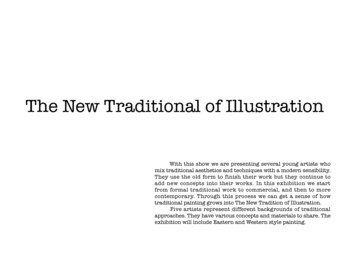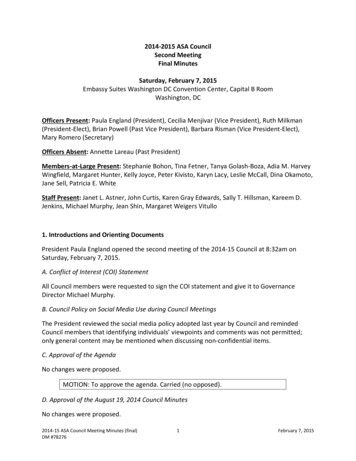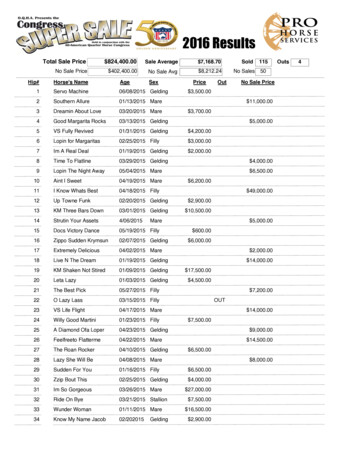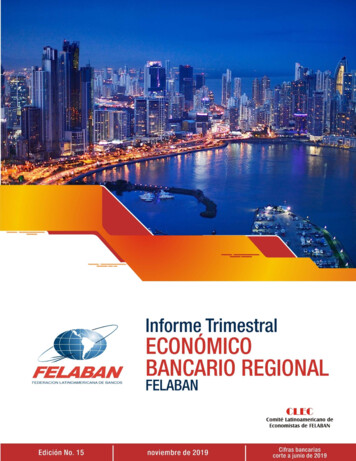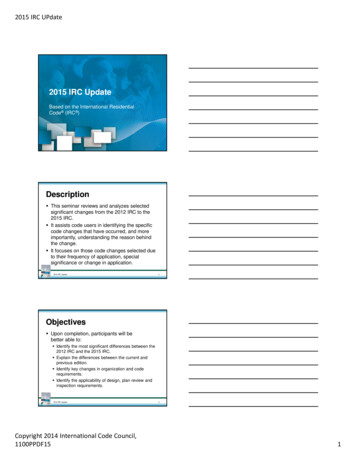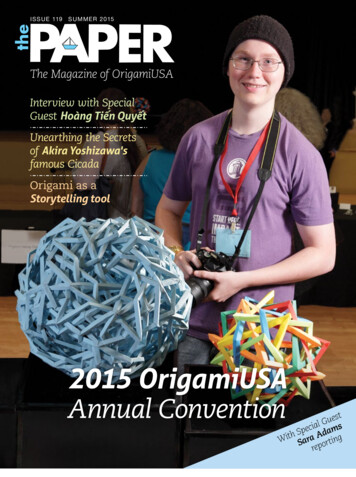
Transcription
I S S U E 119S U M M ER 2015The Magazine of OrigamiUSAInterview with Special Quyˆ Guest Hoàng TiˆenetUnearthing the Secretsof Akira Yoshizawa'sfamous CicadaOrigami as aStorytelling tool2015 OrigamiUSAAnnual ConventionestuGcial amsephSAdWit Sara rtingrepo
In This IssueIssue #119 Summer 2015On the cover:Byriah Loper behind his displayat the 2015 Exhibition. The blueball is “Galaxy,” fifteen interlockingwrinkled octahedra (180 units).On this page: Byriah Loper, AlecSherwin, Aaron Pfitzenmaier,and Zander Bolgar —aka "TheWireframe Guys"— a subgroupof modular origami focusing oninterwoven models. Byriah iscurrently finishing his first bookon wireframe origami! (Photo byLanny Sherwin).FeaturesInterview with Hoàng Tiˆen Quyˆet . . . . . . . . . . . . . . . . . . . . . . . . . . . . . . . . . 8-10The 20-Year Old Cicada by Robert Lang. . . . . . . . . . . . . . . . . . . . . . . . . . . 13-15How the Cicada's Story Came to Life by Laura Rozenberg . . . . . . . . 16-17Like Mother, Like Granddaughter by Laura Rozenberg . . . . . . . . . . . . 18-19Storytelling and Stage Performing with Origami by Yuki Martin . 22-23Show and Tell by Lucia da Costa . . . . . . . . . . . . . . . . . . . . . . . . . . . . . . . . . . . . . 24From YouTube to YourConvention by Sara Adams . . . . . . . . . . . . . . . . 26-27A Field Guide to a (different) Kind of Origami Bookby Ángel Morollón Guallar . . . . . . . . . . . . . . . . . . . . . . . . . . . . . . . . . . . . . . . . 28-29FROM THE HOME-OFFICELetter from the President . . . . . . . . . . . . . . . . . . . . . . . . . . . . . . . . . . . . . . . . . . . . . . 3Errata . . . . . . . . . . . . . . . . . . . . . . . . . . . . . . . . . . . . . . . . . . . . . . . . . . . . . . . . . . . . . . . . . . . 32015 OrigamiUSA Annual Covention . . . . . . . . . . . . . . . . . . . . . . . . . . . . . . . . 4-52015 Origami by Children . . . . . . . . . . . . . . . . . . . . . . . . . . . . . . . . . . . . . . . . . . . 6-7Oversize Competition . . . . . . . . . . . . . . . . . . . . . . . . . . . . . . . . . . . . . . . . . . . . . 20-21OrigamiUSA Awards . . . . . . . . . . . . . . . . . . . . . . . . . . . . . . . . . . . . . . . . . . . . . . . . . . . 25News From the Source and Book Review . . . . . . . . . . . . . . . . . . . . . . . . . 30-31Global Events Calendar . . . . . . . . . . . . . . . . . . . . . . . . . . . . . . . . . . . . . . . . . . . . . . . 32DIAGRAMSBear Hat by Hoàng Tiˆen Quyˆet . . . . . . . . . . . . . . . . . . . . . . . . . . . . . . . . . . . . . . . . 11Cat Hat by Hoàng Tiˆen Quyˆet . . . . . . . . . . . . . . . . . . . . . . . . . . . . . . . . . . . . . . . . . 12BOOK REVIEWSMoney-Gami by Gay Merrill Gross, reviewed by Vishakha Apte . . . . . . . 302 The PAPER Summer 2015the Magazine ofOrigamiUSA(Formerly The Friends of The Origami Center of America)15 West 77th StreetNew York, NY 10024-5192(212) 769-5635fax (212) 769-5668admin@origamiusa.orgVisit our website at:www.origamiusa.orgThe magazine is published by OrigamiUSAto communicate with its members and toshare ideas and information about the artof paperfolding. Mail editorial materialto the Home-Office at the above addresswith “Attention: The Paper” marked clearlyon the envelope, or email to:thepaper@origamiusa.orgThe Paper – Editorial StaffLaura Rozenberg, Managing EditorLanny Sherwin, EditorWendy Zeichner, Advising EditorMarc Kirschenbaum, Diagram EditorGay Merrill Gross, Book Review EditorFaye Goldman, International News EditorGay Merrill Gross, Kathy Wallace, ProofreadersThe Paper CommitteeLaura Rozenberg (Chair),Lanny Sherwin, Wendy ZeichnerOrigamiUSAOrigamiUSA is a volunteer-based not-for-profittax-exempt, cultural and educational artsorganization founded in 1980. Its mission isto share the joy and appreciation ofpaperfolding, preserve its history, nurture itsgrowth, bring people together, and encouragecommunity among paperfolders.FOUNDERSLillian Oppenheimer (1898–1992)Alice Gray (1915–1994)Michael Shall (1950–1995)BOARD OF DIRECTORSWendy Zeichner, PresidentMarc Kischenbaum, Vice PresidentJason Ku, Vice PresidentMarcio Noguchi, SecretaryJean Baden-Gillette, Treasurer Pro temporePatty GrodnerDavid KandelChar MorrowKathleen SheridanUyen NguyenOrigamiUSA STAFFAndrea Brecker, AdministratorMichael and Janet Hamilton,Managers for The Origami SourceVeronica Carman (Editopia Design),Designer for The Paper
Letter from the PresidentDear Folding Friends,This issue of The Paper highlights the2015 Convention held in a new venueat Manhattan College in Riverdale, NewYork. Thanks to Jan Polish, the ConventionCommittee, and everyone who worked tomake this Convention a successful one.I think most would agree that this year’sevent had several ups and downs—some ofwhich were due to the hilly campus! Restassured that the Convention Committee isworking on ways to improve the accessibility issues we encountered. Some of themany up sides at Manhattan College werethe large, modern hospitality room andthe opportunity for attendees to gather inthe cafeteria at meal times, giving the 2015Convention a cozy atmosphere despitethe attendance of over 500 people. We hadtwo wonderful Special Guests—read SaraAdams’ review for details of her experience. An interview with Hoàng Tiến Quyếtis also featured in this issue.There are fascinating articles about AkiraYoshizawa and Gershon Legman—thanksto Robert Lang and Laura Rozenberg forwriting and researching these discoveriesabout the depths of Yoshizawa-san’s work.There are also articles about origami andstorytelling in three different countries.And from Ángel Morollón Guallar, anarticle about the hand-drawn diagrams inhis new book Origami Sketchbook.I met Ángel on my recent trip to Barcelonawhere I attended the Spanish AEP Convention. As an added bonus, I had the chanceto go to Zaragoza and see the celebratedEMOZ origami museum. Thanks to JorgePardo for his hospitality in providing a personal tour for AEP Convention attendees. Iwas naturally overwhelmed and the EMOZexceeded my expectations at every turn.I am always endlessly surprised by thewarmth and immediate connections Ifind when I attend origami conventions.This is especially true when the conventions are in another country and I experience how paperfolders can communicateacross language and cultural barriers —truly the peace of paper in action.New Board members Nguyen Uyen (left) and Kathleen Sheridan (photo by S.Dugan)I hope that many of you will be able toattend the Pacific Coast OrigamiUSA Conference (PCOC) in Boulder on October8 -12, 2015. Registration will open on thewebsite on August 24, 2015. For those ofyou who cannot make it to PCOC, we areplanning on making some parts availablevirtually, including some remote classes. Atthe 2015 Convention, we had nine classesavailable remotely, plus a virtual tripthrough the exhibition and a live broadcastof the Oversize Folding event. Both videosare available on the website at origamiusa.org/convention2015 galleries.At the Annual Meeting we held the 2015elections. We welcome two new BoardMembers, Kathleen Sheridan and UyenNguyen (Win-Win) and look forward totheir contributions. Stepping down fromthe Board are Lisa Bellan-Boyer and JeanBaden-Gillette. We thank Lisa for hertwo years of service and Jean’s recent sixyears of service, totaling 24 years of Boardservice. Thank you!I hope to see many of you soon!Happy Folding!OrigamiUSA PresidentJuly 24, 2015ErrataSome images of the Holiday Treepublished in the last issue of The Paper(#118, pages 5-6) were incorrectlycredited. The correct credits are as follows:designed by Delrosa Marshall.1. The blue whale was designedby Satoshi Kamiya and folded byGabriel Sherman.5. Banana and green tree were foldedby Ros Joyce.2. The keys being held by the monkeywere folded by Talo Kawasaki.3. The little book on page 6 was4. The Biplane was folded byTalo Kawasaki.6. Robert Lang's Pterosaurus wasfolded by Alfred Kwan.7. The standing grey Jason Ku'sPterosaurus was folded by Mike Verry.Summer 2015 The PAPER 3
2015 OrigamiUSAAnnual ConventionJune 19-22, 2015 - Manhattan College, Riverdale, NYPhotos by Andrew Cribb,*Susan Dugan**Maxwell Jones (left), Tovi Wen, and Tristan Saidi takepart in a class rated super complex in which ConnerBeavers taught Satoshi Kamiya Ancient Dragon model.*Heat set fabric origami class with UyenNguyen. Christiane Bettens heats thepaper and fabric to set the folds.*First timers—Andrew Nordell andhis dad.*Martha Landy with American Robin designed by andtaught by Winston Lee.* Quyˆ class holding their wetfolded gold fish.**Hoàng Tiˆenet's4 The PAPER Summer 2015Laura Kruskal showing offthe 2015 OrigamiUSA Crowndesigned and folded by her.**
Mice designed and folded by Quyˆ Hoàng Tiˆenet.*Yellowfin tuna (Thunnus albacares),designed and folded by Bernard Peyton III.*Swedish Star Wreath class by teacher Sandra Richman. James Brown shows off theprogress he has made.*Atlantic wolffish (Anarhichas lupus),designed and folded by Bernard Peyton III.*Octopus designed and folded by Brian Chan.*First timer, Sarah Beitel (NJ).*Dante Castro (left) teaching Alec Thompsonthe Fiery Dragon, a design by Kade Chan.*Uyen Nguyen teaches an afternoon class—her Rose Auditorium design.*Summer 2015 The PAPER 5
2015 OrigamiUSA Annual ConventionOrigami by ChildrenFor more than three decades, OrigamiUSA has sponsored Origami by Children,an annual exhibition of outstanding origami by children from around the world.Children whose origami is selected forthe exhibition will receive a Certificate ofMerit, a one-year membership to OrigamiUSA and a small gift. Experience isnot necessary and every interested childis welcome to participate. Most modelsare made from directions in origamibooks available in libraries, bookstores,and online. However, original creationsare especially encouraged.Every year children are invited tosubmit their best folded models; eithertheir own creations or the designs ofothers. The finest of these are selectedto become the Origami By Childrenexhibit for that year. The exhibit travelsto the communities of the various participants where it is displayed in localschools and libraries.Photographs by Mary GordonGerman Shepherd,folded by Ben WalleyWestern Pond Turtle,folded by Evan DeddoBoat, foldedby Jean-Luc LeBahamut (Divine Dragon)Folded by Krishna Girkar (12) CA,USACreated by Satoshi KamiyaSpread Hexagon TessellationFolded by Kai Anderson (8) WA,USACreated by Eric GjerdeOrigamido ButterflyFolded by Michael Cheng (14) PA,USACreated by Michael LaFosseBat Pop-Up CardFolded by Jonah Bard (11) CA, USACreated by Jeremy ShaferOrigami Tic Tac Toe Game SetSapito-Little ToadBlack RocketFolded by Grayson Cliff (13) CA, USA Folded by Ksenia Glushko (7) Ukraine Folded by Ulysses Jacobs (5) NY, USACreated by KDianne StephensCreated by Roman DiazCreated by Ulysses JacobsGato (Cat)Folded by Nathan Boerner (14) OH,USACreated by Román DíazWestern Pond TurtleFolded by Evan Deddo (16) PA, USACreated by Robert LangDogFolded by Peter Haber (15) NH, USACreated by Peter HaberViolinistFolded by Oliver Jiang (14) CA, USACreated by Oliver JiangDragonFolded by Alec Drzewiecki (16) CT,USACreated by Alec DrzewieckiPersonFolded by Peter Haber (15) NH, USACreated by Peter HaberOwlFolded by Emily Kwan (18) NJ, USACreated by Joseph WuMinotaurFolded by Jesper Brenner (13) MA,USACreated by Satoshi KamiyaStar BowlFolded by Wesley Cassidy (14)Ontario, CanadaCreated by Dasa SeverovaSnowflake BoxFolded by Curtis Chang (11) NY,USACreated by Curtis ChangLily FlowersFolded by Katherine Chen (9) NY,USATraditional6 The PAPER Summer 2015PhoenixFolded by Alec Drzewiecki (16) CT,USACreated by Alec DrzewieckiJedi Master YotaFolded by Bob French (12) NY, USACreated by Fumiaki KawahataFlying PigFolded by Mark Gillespie (18) NJ,USACreated by Mark GillespieValentine's CraneFolded by Nathan Houser (10) IN,USACreated by Nathan HouserBeetlePHiZZ Origami BuckyballFolded by Theo Harpaz (11) CA, USA Folded by Ben Labuzzetta (13) WI,Created by Jo NakashimaUSACreated by Tom HullElephantFolded by Aaron Hedgpeth (9) AZ, USA Spiky Honeycomb CorrugationFolded by Carly Lam (14) NY, USACreated by Nick RobinsonCreated by Carly LamGiraffeBoatFolded by Jacob Hedgpeth (11) AZ,Folded by Jean-Luc Le (5) NY, USAUSATraditionalCreated by Gen HagiwaraGolden Long Horned BeetleFolded by Tom Hougen (12) IL, USACreated by Tom HougenSix intersecting pentagramsFolded by Leon Lei (17) NY, USACreated by Francesco Mancini
2015 OBC FactsValentine Crane,folded by NathanHouser 87 participants, ages 5-18 5 countries represented 135 entries 39 were individual creators submitting 53 of their own original designs. 25 winners’ own works are in the 2015 OBC collection. The youngest creator is 5 years old!Dragon and Phoenix,folded by Alec DrzewieckViolinist,foldedby OliverJiangBeetle,folded byTheo HarpazOwl, foldedby EmilyKwanKit FoxFolded by Julie Ma (13) MA, USACreated by Bernie PeytonStag BeetleFolded by Andrew Mao (14) MD,USACreated by Andrew MaoDouble Triangle SawtoothFolded by Liam Marshall (14) WI,USACreated by Miguel Angel BlancoMunoz36-Unit Structure TruncatedOctahedronFolded by Alec Marshall (12) WI,USACreated by Tomoko FuseTableFolded by Avery McElroy (13) VT,USACreated by Avery McElroyFiery DragonFolded by Justin Shim (14) MD, USACreated by Kade ChanTravel Picture FrameFolded by Raylen Weaver (7) NJ, USACreated by Margaret Van SicklenWoof Woof!Folded by Simon Shimel (15) WA,USACreated by Simon ShimelEvil WizardFolded by Henry Weinschel (8) NY,USACreated by Henry WeinschelHappy ManCrabFolded by Simon Shimel (15) WA,Folded by Sergio Sanchez (18) OR, USA USACreated by Simon ShimelCreated by Sergio SanchezReef LobsterFolded by Tovi Wen (11) NY, USACreated by Tovi WenVerdi's VaseFolded by Theodore Pribadi (13) CA,USATraditionalStar Diamond KusudamaFolded by Charul Rajendra Patil (14)Maharashtra, IndiaCreated by Charul Rajendra PatilJapanese Rhinoceros BeetleFolded by Sergio Sanchez (18) OR,USACreated by Sergio SanchezVampire BatFolded by Louis Squitieri (15) WI,USACreated by Dao Cuong QuyetLumo's SpiderFolded by Lumo Sato (11) CT, USACreated by Lumo SatoNightmare MonsterFolded by Graham Stearns (11) WI,USACreated by Graham StearnsSparrowFolded by Nilay Shah (16) GA, USACreated by Alfredo GiuntaTiered Garden No. 1Folded by Keith Meyers (14) WI, USA Peek-a-Boo Spike BallCreated by Keith MeyersFolded by Gabriel Sherman (14) NY,USAF-22Created by Francis Ow's 60 UnitFolded by Sejin Park (14) South Korea Icosahedron & Thomas Hull's 5Created by Sejin ParkIntersecting TetrahedraLily BoxFolded by Sophie Usherwood (12)NH, USACreated by Tomoko FuseGerman ShepherdFolded by Ben Walley (17) MO, USACreated by Ben WalleyCardinalFolded by August Westphal (8) MI,USACreated by Roman DiazI Ching WheelFolded by Harry Westphal (6) MI,USACreated by Michael LaFosseNavel ShellFolded by Daniel Yang (15) CA, USACreated by Tomoko FuseScorpionFolded by Jovan Zelen (11) OR, USACreated by Jovan ZelenSummer 2015 The PAPER 7
ˆ Quyetˆ Interview Hoàng TienFolding withStyle and Grace Quyˆet Special Guest Hoàng Tiˆenteaching his Fluffy Cat at the AnnualConvention. (Photo by Andrew Cribb)Interview with LauraRozenbergOne of my regrets of not being able toattend this year's OrigamiUSA Convention was the fact that I would not be ableto meet the special guests. Hoàng TiếnQuyết's elegant models always fascinatedme since I began to see his works throughpictures in Flickr and other websites. Inmy personal opinion there is a limit to“how much” we can ask of a creator froma diagram. Beyond that, it's all about8 The PAPER Summer 2015artistry, and Quyết's style, while not socomplicated to fold as other artist's works,bears this intangible quality that makesit so unique. In the following conversation, I tried to learn more about the manbehind the elegant curved foldings.You are one of these experts whose modelsare easy to identify as a creation of yours.How do you achieve your personal style?What do you intend to convey in each piece?I would like to express new ideas and mypersonality in each piece. I usually imaginemyself in the position of models I would liketo fold, to understand how I would want tobe if I were them, to know if they (or me)would be better or worse if I add or deductsome folds. So there are always connectionsbetween me and my models. Maybe that’sthe reason why I discovered my style verynaturally. I didn’t even need to think how mystyle should be at first. It’s just about expressing myself, my interests.You became a member of the VietnameseOrigami Group on February 2, 2006,
hand painting colors, back-coating two ormore layers to have the thickness I need.But it's worth it! And I'm really satisfiedwith Dó paper. I'm not sure if Dó will beavailable on Origami-shop.com in near future, but Nicolas Terry once told he wouldsell it soon!Tells us a bit about the history of paperfolding in Vietnam.We haven’t had any research about thehistory of origami in Vietnam, but as Ilearned from some old people, they weretaught origami by their grandparents andbelieved origami in Vietnam had hundredsof years of history. It’s possible becausepaper was also handmade in Vietnam over1,000 years ago. There are also some traditional models in Vietnam that haven't beenfound in any books from other countries.When did you start folding and why?I started folding at about 5 or 6. My cousintaught me how to fold a plane and a boat.It was a joy of a kid who could make hisown toy. I folded them again and againuntil I got my first book when I was about7, a photocopy that a neighbor gave me.He taught me to understand symbols so Icould fold by myself.Dancing Swan, created in 2009.Folded with watercolor paper. Quyˆ (Photo courtesy of Hoàng Tiˆenet)and you made a special remark lastyear on Facebook, on the day of your8th membership anniversary. Why is itso important that you remember thatday so clearly?Actually it’s February 3rd in Vietnamesetime. It’s special for me because beforejoining VOG, I was just a lone folder.Friends around me liked what I did butrarely tried or would lose their interestquickly. At the time, I was so happy that Ifinally found a place with so many enthusiasts like me.What kind of paper do you prefer? Arethere special papers in Vietnam that weWesterners may not be aware of?As I usually wet-fold my models. I preferthick paper. A very good example isArches watercolor paper, one of the bestpapers I’ve tried.At the moment I use a Vietnamese handmade paper called “Dó” for most of myrecent models, such as the Lion, Unicorn,Rats, Rooster. It's a nice paper, but quitedifficult to use. I need to re-strengthen itbefore using, such as adding more glue,Since your models so special and “artsy,” isit still possible to produce diagrams? Thereis something in a diagram that escapesexplanation —the hand of the artist—?It's actually a challenge for me to makediagrams of my recent models as I use lotsof improvised folds—sometimes I am noteven able to re-fold them! However I alsoprefer people not just follow my instructions and copy my models' appearances,but have their own touch! I hope I canfind a way to express that in my futurediagrams.What's your most popular model?Perhaps it's the Dancing Swan 2009, as it'sprobably my most folded model.What's your favorite creation?The Lion 2012 and Wind-horse 2012 aremy favorites. Out of all my work, I'd liketo be them the most. However I still wantto develop these two in the future, there isstill room for new ideas. Summer 2015 The PAPER 9
ˆ Quyetˆ Interview Hoàng TienWhat's your background? Did you studyart or something related?I graduated from Economics University;not related to origami indeed, but I was nota really good student.I took a drawing course when I was in myfirst year of economics, and also passed theentrance exams to Architecture Universityafter that, but I finally made a decision notto leave economics.I'm just happy with things I studied duringuniversity time and happy with myself atthe moment. I would still choose economicsif I had another chance.How old are you and for how many yearsyou have been folding?I will be 27 in next September, so I'm about21 origami years old, still young and need tolearn more.Is it wet-folding what you do to shape themodels?Yes. Moreover, I also design models specifically for wet-folding.Do you use tools (e.g. creasers, pencils toround up the edges, etc.)Sometimes, when I do some tiny details,but normally I prefer using hands. I feel myhands are more restricted if I use tools.Do you use any material to stiffen themodel once it’s ready?THE V.O.G. Quyˆ in 2012. Folded using Vietnamese handmade paper.Lion, created by Hoàng Tiˆenet Quyˆ (Photo courtesy of Hoàng Tiˆenet)Yes, depending on which models, sometimes I use wire to keep them in shape orbeing able to stand, like the rooster.What is it like to live in Vietnam? Do youhave a lot of spare time? When do you fold?On the train, during vacations? Every day?After work? Does folding take all the timein your life?Origami is nearly everything for me at themoment. I think about it from the momentby Hoàng Tiến QuyếtVietnam Origami Group forum was established to be the first place to connectOrigami enthusiasts in Vietnam. We also attended and organized someevents to promote origami in Vietnam, but not any professional conventionyet. We are also holding a club in Hanoi, where we meet weekly. There areregularly 10 to 15 members who attend each time. Most members of VOGare still very young, around 25 years old and less, very few are over 30.At the moment, the forum is silent —less people visit it compared to fewyears ago. Facebook is so popular and is the preferred place for everyone.But I think the VOG forum did its job. The community has been expandingsignificantly since the forum started in 2005. In the future we would like toorganize origami conventions more regularly to re-connect members again,meeting each other in person, which Facebook can’t do. Magazines will befor the future too.10 The PAPER Summer 2015I get up, when I am in a bus, on my bike,and even in dreams. Normally I have lotsof free time and I spend it for building newideas, creating new concepts. SometimesI’m busy with projects for days or weeks.However working as an origami artist isnot easy. I earned some projects in Vietnamand from abroad, and sold my models,diagrams, and it's just enough for a life inVietnam—that's enough for me. I choosemy joy to be folding paper.What do your non-origami friends sayabout your artwork?Luckily they like my work. Sadly no onewants to learn how to fold!Do you exhibit in your country orinternationally?Yes for both. I sent my work to some international exhibitions. The most recent isSurface to Structures. I have also cooperatedwith some friends in Vietnam to open someshort-time exhibitions.What are your origami plans for the future?There are some ideas and projectsI would like to do in near future. However,I’m not a well-organized person,so I keep it simple. All I want is to foldwhen I get up tomorrow.
BEAR HATIntermediateDesign & Diagram: Hoàng Tiến Quyết Summer 2015 The PAPER 11
CAT HATDesign & Diagram: Hoàng Tiến Quyết 12 The PAPER Summer 2015Intermediate
An Origami Detective Story PART IThe 20-Year Old CicadaA set of photographs almost forgotten inthe South of France for more than half acentury, sparked Robert Lang's interestto unravel the secrets of one of the mostcomplex models created by the greatJapanese master Akira Yoshizawa: the Cicada.by Robert Lang (CA)In the mid-1980s, when I was a young folder and eager to makemy mark, Friends of The Origami Center of America's co-founderand origami artist Alice Gray told me about her encounterwith Akira Yoshizawa at which he showed her his cicada, andhe remarked that it had taken him over twenty years to design!“Hmmph!” I thought. “I don’t need no twenty years to design acicada!” And I sat down and designed one, which I became veryproud of. (So proud that I put it in my first book.) But after a fewyears, I began to perceive its flaws: the body wasn’t quite right, thewings weren’t positioned properly, the legs looked too generic. SoI set about to design another. “Now,” I thought, “I’ve got it right.”But presently, that one, too, began to display weaknesses. Andso another. And in a few years more, yet another. None ever “hitthe mark.” In 2003, I attended a Japanese origami convention andduring a visit to the city of Shizuoka during the cicada emergenceseason, I looked closely at the cicadas on the trees all around andrealized once again the flaws in all that I had folded before, and setout once more. The result was a figure I titled “Shizuoka Cicada,opus 445.” And finally, I thought, I nailed it. But, you know, when Ilook at a calendar it had been about twenty-five years since I firststarted working on this subject. So I overshot him by a few years,and I guess that twenty years is not too long to fold a cicada.The Magic of the CicadaYoshizawa’s Cicada illustrates a remarkable fact about the man: hepublished many books with hundreds of folding diagrams, and yetall of his published work only hinted at the sophisticated design techniques that he had developed, in isolation, on his own. Today, theorigami world has conceptual tools for design, with names like “circlepacking,” “tree theory,” “molecules,” and more. In the 1940s and1950s, the most sophisticated concept to arise in the world of origamiwas the idea of gluing two bird bases together, and perhaps usinga few cuts here and there to obtain some extra features. Yoshizawalearned origami within that design culture, but set himself a goal tocreate the most detailed and realistic forms from a single uncut sheetFig. 1: Upper row: Yoshizawa’s Cicada, folded, and the planfrom his notebook. Lower row: his Cicada Nymph.of paper. To accomplish this, he devised entirely new folded structures that would not be re-discovered by others until decades later.None show these innovations more clearly than his Cicada.Yoshizawa’s Cicada was his pride and joy; time and again, in interviews over the years, he cited it as his masterpiece. In fact, he completed it in 1959, having worked on it for over 23 years, according toa 1970 interview. Now, it is unlikely that he worked on that specificdesign for that period of time; rather, it took 23 years to develop theconcepts that could be brought together to realize it. Those concepts would include the pattern of folds, the choice of paper and theunderstanding of how it would respond to manipulations, and thefolding skill to persuade the paper to take on the folds specified bythe pattern. All of those skills were necessary to realize the artwork,but the artwork began with a folding pattern, and the folding patternfor the Cicada was like nothing that had come before.“20 years is not enoughto fold a cicada”In the early 1950s, Yoshizawa began corresponding with Gershon Legman, an expatriate American living in France who haddeveloped a passion for origami and its history. It was Legmanwho brought Yoshizawa to the attention of the world and whoarranged for Yoshizawa’s first international exhibition in 1955at the Stedjelik Museum in Amsterdam. Yoshizawa and Legmandeveloped a deep friendship, expressed through their correspondence, and in 1962, three years after his Cicada milestone,Yoshizawa shared with Legman that which he was so proud of: hisCicada and its construction, via a photograph of the model and itsfolding plan from his notebook (Fig. 1).Summer 2015 The PAPER 13
An Origami Detective Story PART IIn fact, the notebook contained descriptions of two designs: an adult cicada(above) and a juvenile (nymph, below).Both are folded from a 2x1 rectangle andeach from the same base, which resemblesa tiling of eight Bird Bases, shown herein my transcription of his pattern for theadult. The tiling shows a clear ancestrywith one of Yoshizawa’s earlier complexdesigns, his Crab. The Crab was foldedfrom a “double-blintzed Frog Base,” to usethe modern terminology. The base for hisCicada could be thought of as two suchdouble-blintzed Frog Bases attached sideby-side (Fig. 2).Such a pattern, however, demands anentirely different folding approach fromFig. 2: Yoshizawa’s plan for the Cicada.the traditional step-by-step designs. With this pattern, onemust pre-crease all of the relevant creases, then bring them alltogether at once, in an action now called a “collapse.” Astonishingly, Yoshizawa shared the details of this collapse with Legmanin a series of photographs that showed precisely how this basecame together (Fig. 3).Fig. 3: The collapse of the Cicada base.14 The PAPER Summer 2015A key aspect of the collapse was the the “tucking underneath” ofa portion of the paper at several places, indicated by the shadedregions on the collapse photographs, and highlighted by Yoshizawa in his crease pattern by drawing explicit mountain foldlines—dash-dot-dot—on the otherwise unmarked crease patterns.In the modern era of complex design, “collapses” are ubiquitous.60 years ago, however, they were all but unknown. The complexity of this base, and the necessity of constructing it via a collapsemove, were part of Yoshizawa’s “secret sauce” for creating complexdesigns. And yes, it was secret. Although he shared the designwith Legman (perhaps flush with pride at its recent creation), henever published instructions for this type of work in any of hisbooks. We might well wonder why that was. Could it be that hewished to keep some of his methods a secret? Could it be that hefelt that diagrams would not adequately convey what folds wouldneed to be carried out? Perhaps he simply felt that the challengeof creating these folds would be so far beyond the skills of mostreaders that the diagramming effort would be unjustified. Alas,we will never know. There is no question that further challengeswould have awaited anyone who would seek to fold this design.In later years, Yoshizawa shared further details of the a
For more than three decades, Origami-uSA has sponsored Origami by Children, an annual exhibition of outstanding ori-gami by children from around the world. Children whose origami is selected for the exhibition will receive a Certificate of Merit, a one-year

